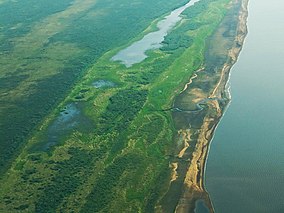| Old Crow Flats | |
|---|---|
| Van Tat | |
| IUCN category IV (habitat/species management area) | |
 Shoreline of a large lake in Old Crow Flats Shoreline of a large lake in Old Crow Flats | |
| Area | 6,170 km (2,380 sq mi) |
| Ramsar Wetland | |
| Designated | 24 May 1982 |
| Reference no. | 244 |
Old Crow Flats (Van Tat in the Gwichʼin language) is a 6,170 km (2,382 sq mi) wetland complex in northern Yukon, Canada along the Old Crow River. It is north of the Arctic Circle and south of the Beaufort Sea, and is nearly surrounded by mountains.
Site
The site is protected by the Yukon Wildlife Ordinance and Migratory Birds Convention Act. It was identified as part of the International Biological Program inventory, and was designated a wetland of international importance via the Ramsar Convention on May 24, 1982.
The habitat is an important breeding area for aquatic mammals and peregrine falcons, is used for summer moulting by waterfowl, and is an autumn staging site for various species of birds. For these reasons, it is considered an Important Bird Area.
Per the Vuntut Gwitchin Final Agreement, the southern extent of Old Crow Flats (approximately 7,785 km) is classified as a Special Management Area by the Yukon Government; the northern portion is now part of Vuntut National Park. Old Crow Flats contains more than 2,000 ponds and marshes.
Archaeology
The archaeological sites in the area demonstrate some of the earliest human habitation in North America. More than 20,000 fossils have been collected in the area, including some never before reported in North America.
The Bluefish Caves, another important area with early human presence, are located about 75 km southwest of the Old Crow Flats.
Fossils and artifacts
Many northern Yukon rivers, including Old Crow River and Porcupine River, changed course relatively recently, and cut through the fossil-bearing deposits. As a result, millions of fossils were eroded from the bluffs and redeposited in new riverbanks.
Many animals are represented in fossils uncovered in Old Crow Flats, including mammoths, mastodons, giant beavers, ground sloths, camels, horses, giant bison, short-faced bears, American lions, and short-faced skunks, among others. Mammoth bones radiocarbon dated between 25,000 and 40,000 years old display signs of human tool production and butchery.
See also
References
- ^ Vuntut Gwich’in Waters
- "Old Crow Flats". Ramsar Sites Information Service. Retrieved 25 April 2018.
- "Life on the Flats". Vuntut Gwitchin First Nation. Retrieved 2007-08-05.
- ^ "Old Crow Flats". Archived from the original on May 9, 2008. Retrieved 2016-04-04.
- "Old Crow Flats". IBA Canada. Retrieved 2016-04-04.
- "Habitat Protection and Special Management Areas". Environment Yukon. Archived from the original on 2007-04-26. Retrieved 2007-08-05.
- "Old Crow Flats Special Management Area". New Parks North. Archived from the original on 28 September 2007. Retrieved 2007-08-05.
- "The Annotated Ramsar List of Wetlands of International Importance - CANADA". Ramsar Convention Bureau. Archived from the original on 2007-07-15. Retrieved 2007-08-05.
- J. Cinq-Mars (2001), On the significance of modified mammoth bones from eastern Beringia.
- ^ Richard E. Morlan (2012), Old Crow Basin. The Canadian Encyclopedia
Further reading
- Morlan, Richard E. NbVk-1 An Historic Fishing Camp in Old Crow Flats, Northern Yukon Territory. Ottawa: National Museum of Man, National Museums of Canada, 1972.
External links
| Protected areas of Yukon | |
|---|---|
| National parks | |
| National historic sites | |
| Territorial parks |
|
| Marine Protected Areas | |
| National Wildlife Areas | |
| Other | |
67°26′28″N 139°49′12″W / 67.441°N 139.82°W / 67.441; -139.82